CH6 Synchronization
雙二一退學保衛戰。
The Critical-Section Problem

Critical-Section:
關鍵區段,指的是存取共用資源的片段程式碼。這些共用資源有無法同時被存取的特性。
Ex. Memory Access, Disk IO.
Solution
- Mutual Exclusion(互斥): 任一個時間點只允許一個行程進入他的Critical-Section。
- Progress:
- 不想進入Critical-Section的行程,不可參與其他行程進入Critical-Section的決策。
- 必須在有限時間內從想進入Critical-Section的行程中挑選一個進入。
隱含No Deadlock。(有空位就讓
想進的人馬上進去)
- Bounded waiting:
- 從一個行程提出進入Critical-Section到獲准進入之間的等待時間是有限的。
- 如果有n個行程在等待,那麼每個行程最多等待n-1段時間即可進入Critical-Section。 隱含No starvation。
Peterson’s Solution
- 適合兩個行程。
- 假設
load以及store兩個方法具有原子性,無法被中斷。 - 兩個行程共享兩個變數:
- int turn: 決定輪到哪個行程進入Critical-Section
- boolean flag[2]: 旗標代表行程是否準備進入Critical-Section
1
2
3
4
5
6
7
8do {
flag[i] = true;
turn = j;
while(flag[j] && turn == j);
critical section
flag[i] = false;
remainder section
} while (true);
Synchronization Hardware
- 用Lock來達到保護Critical Region(關鍵區域)的目的。
- 單處理器:可以禁用中斷。
- 當前運行的程式不會被插隊(without preemption)
- 通常在多處理器上效率太低, 作業系統不能廣泛的擴展。
- 當代的機器多提供特殊的原子性指令,意即不會被中斷。 ### test_and_set instruction
1
2
3
4
5
6do {
acquire lock
ciritical section
release lock
remainder section
} while(true); - 兩行程執行時,在前次行程釋放鎖之前,其他行程都會在
while前阻塞。 - Define
1
2
3
4
5boolean test_and_set (boolean *target) {
boolean rv = *target;
*target = TRUE;
return rv:
} - Usage
- 共享
lock變數, 初始值為False1
2
3
4
5
6
7do {
while (test_and_set(&lock));
/* do nothing */
/* critical section */
lock = false;
/* remainder section */
} while (true);
- 共享
compare_and_swap instruction
- 如果鎖的狀態跟預期的
False,行程就可以取得當次執行Critical Section的權力,否則就會在while前阻塞。 - Define
1
2
3
4
5
6int compare_and_swap(int *value, int expected, int new_value) {
int temp = *value;
if (*value == expected)
*value = new_value;
return temp;
} - Usage
- 共享
lock變數, 初始值為False1
2
3
4
5
6
7do {
while (compare_and_swap(&lock, 0, 1) != 0);
/* do nothing */
/* critical section */
lock = 0;
/* remainder section */
} while (true);
- 共享
Mutex Locks
- 前面的方法太複雜,而且通常應用程式的Programmer沒辦法存取。
- OS的設計者會提供軟體工具來解決Critical-Section Problem
- Mutex Lock就是最簡單的作法。
acquire用來取得鎖,release用來釋放鎖。- 這兩個方法必須是原子性,才不會被打斷。
- 通常會用硬體指令來實作。
- 但是這個解法必須使用
busy waiting:拿到鎖之前,等到海枯石爛。- 這個鎖也被稱為
Spin Lock
- 這個鎖也被稱為
acquire() and release()
1 | acquire() { |
Semaphores
- 拿到鎖之前不用等到海枯石爛,但是如果沒有鎖可以拿,還是會等到海枯石爛。
1
2
3
4
5
6
7
8
9wait (S) {
while (S <= 0);
// busy wait
S--;
}
signal (S) {
S++;
}
Usage
- Counting Semaphores: 整數計數器
- Binary Semaphores: 二進位計數器
- 類似Mutex(邏輯上)
1
2
3
4
5
6
7P1:
S1;
signal(synch);
P2:
wait(synch);
S2;
- 類似Mutex(邏輯上)
Semaphore Implementation
- 沒人懂這在講什麼鬼…
- 必須保證同一個信號內的
signal跟wait不會同時在兩個不同的行程中呼叫 - 當
signal跟wait被放在Critical Section中的時候,會變成Critical Section Problem - 現在多使用
busy waiting來實作- 程式碼少
- 但是效率低
- 應用程式可能花很多時間在waiting,所以不是很好的方法。
Semaphore Implementation with no Busy waiting
- 每一個
semaphore都有一個關聯的等待佇列(waiting queue) - 佇列中的每一項都包含有兩個資料元素
- 數值(integer)
- 下一項的指標
- 兩種操作
- block: 把行程放在適當的等待佇列中
- wakeup: 把行程從等待佇列放到就緒佇列(ready queue)中
1
2
3
4
5
6
7
8
9
10
11
12
13
14
15
16
17
18
19
20typedef struct {
int value;
struct process *list;
} semaphore;
wait(semaphore *S) {
S->value--;
if (S->value < 0) {
// add this process to S->list;
block();
}
}
signal(semaphore *S) {
S->value++;
if (S->value <= 0) {
// remove a process P from S->list;
wakeup(P);
}
}
Deadlock and Starvation
- Deadlock 兩個或更多的行程在互相等待各自的資源釋放。 A等B放開鎖, B也在等A放開鎖。 等到海枯石爛。
- Starvation: 阻塞到死。 行程沒有從等待佇列被放到就緒佇列。
- Priority Inversion:
- 高優先權行程的資源被低優先權行程占住了。 必須要等待低優先行程釋放才能繼續。
- 透過priority-inheritance protocol解決
Classic Problems of Synchronization
Bounded-Buffer Problem
- Variable
- n個Buffer, 每個可以放一個元素
- Semaphore mutex, 初始值為
1: 控制生產者跟消費者存取Buffer - Semaphore full, 初始值為
0- 表示目前Buffer有多少空間被使用
- 0表示Buffer是空的,消費者要等待
- Semaphore empty, 初始值為
n- 表示目前Buffer還有多少空間
- <=0表示Buffer是滿的, 生產者要等待
- 生產者(Producer)行程
1
2
3
4
5
6
7
8
9
10
11
12do {
...
/* produce an item in next_produced */
...
wait(empty);
wait(mutex);
...
/* add next produced to the buffer */
...
signal(mutex);
signal(full);
} while (true); - 消費者(Consumer)行程
1
2
3
4
5
6
7
8
9
10
11
12do {
wait(full);
wait(mutex);
...
/* remove an item from buffer to next_consumed */
...
signal(mutex);
signal(empty);
...
/* consume the item in next consumed */
...
} while (true);
Readers-Writers Problem
- 數個同時執行的行程,共享資料集合
- Readers: 只讀取資料, 不會對資料做任何更動。
- Writers: 同時可以讀寫。
- 問題:允許數個Reader同時讀取資料。 只有單一個Writer可以讀寫資料。
- Reader跟Writer的數種變化取決於優先權(Priority)
- 共享資料
- 資料集合
- Semaphore rw_mutex, 初始值為
1- 控制Reader/Writer進入文件的信號
- 0代表有人正在存取文件, 需要等待
- Semaphore mutex, 初始值為
1- 控制reader_count增減的信號
- 0代表reader_count正在變動,需要等待
- 整數reader_count,
初始值為
0:用來計算現在有幾個Reader
- Writer行程
1
2
3
4
5
6
7do {
wait(rw_mutex);
...
/* writing is performed */
...
signal(rw_mutex);
} while (true); - Reader行程 #### Readers-Writers Problem Variations
1
2
3
4
5
6
7
8
9
10
11
12
13
14
15do {
wait(mutex);
read_count++;
if (read_count == 1)
wait(rw_mutex);
signal(mutex);
...
/* reading is performed */
...
wait(mutex);
read_count--;
if (read_count == 0)
signal(rw_mutex);
signal(mutex);
} while (true); - Variation 1 如果有無限個Reader在讀取,Writer會餓死(Starvation)。
- Variation 2 Writer準備好之後就馬上開始讀寫,Reader會餓死
- 某些系統為了解決這些問題, 會由Kernel提供讀寫鎖(Reader-Writer Lock)
Dining-Philosophers Problem

- 哲學家只能思考(Wait)或吃飯(Do),他們之間不能交流,
每次吃飯都需要同時拿左邊跟右邊的筷子,吃完就會把筷子放回去。 - 問題: -
哲學家想吃飯的時候,但是左邊或右邊的任一支筷子被拿走了,需要等待。 -
共享資料: - 飯(資料集合) - Semaphores 筷子[5],
初始值是1: 0代表有人在用 - 行程 1
2
3
4
5
6
7
8do {
wait ( chopstick[i] );
wait ( chopStick[ (i + 1) % 5] );
// eat
signal ( chopstick[i] );
signal (chopstick[ (i + 1) % 5] );
// think
} while (TRUE);
Problem of this algorithm
- 會產生死鎖(Deadlock):要等其他人放下筷子, 才能拿筷子。
- 大家都先拿右邊的筷子, 全部的人都在等左邊的筷子, 可是左邊筷子已經被左邊的人先拿走了。
- 如果哲學家1, 3一直拿著筷子, 哲學家2就會等到死。
- 解法
- 最多限制(n - 1)個吃,可以解決死鎖,但是會有人餓死。
- 除非可以拿到左右筷子,不然就不准吃。 可以打破Hold-and-Wait(死鎖),但是也是會有人餓死。
- 奇數者先拿左邊再拿右邊,偶數者則相反, 可以打破Circular Waiting(環狀等待), 還是會有人餓死。
- Chandy/Misra Solution: 先把筷子湊成對, 要吃的領筷子券, 吃完再釋放 搶奪筷子券,沒有錯,還是會有人餓死。
- 所以你們就餓死吧…
Problems with Semaphores
- Semaphore的不正確操作
- signal() 再 wait() 先加信號再等待信號???… 怪怪的
- wait() 又 wait() 等一個信號 然後又等一個信號??? … 等一個人咖啡館???
- 省略了signal或wait或兩個都省略了 不等了, 或者不把信號還回去, 直接出車禍.
- 死鎖(Deadlock)跟餓死(Starvation)